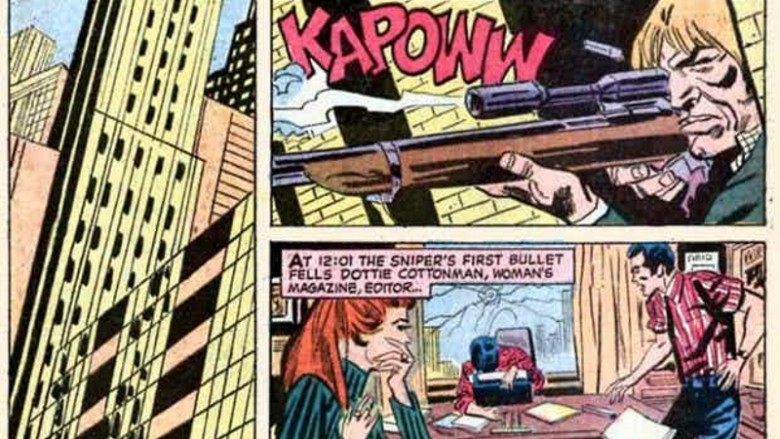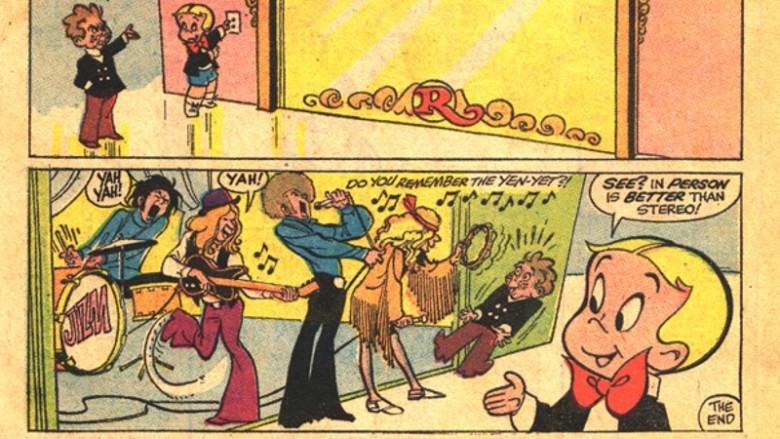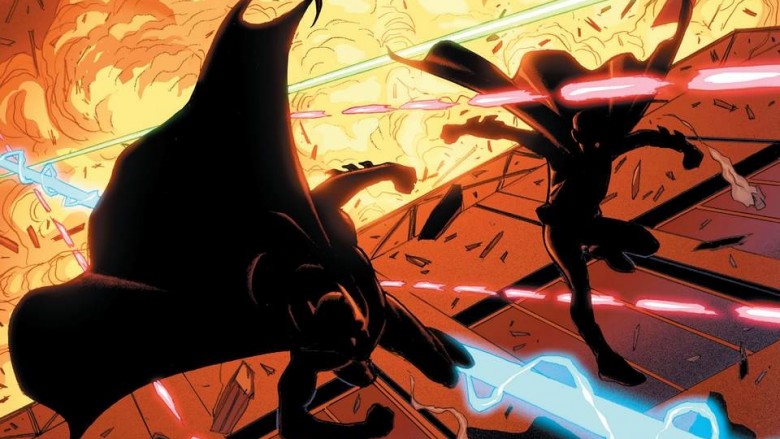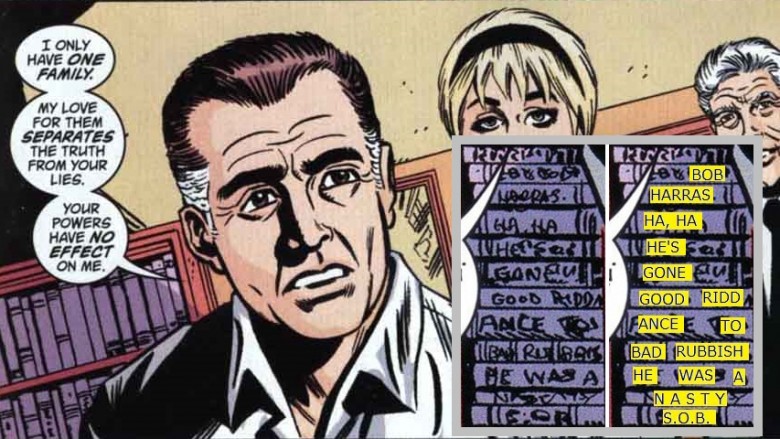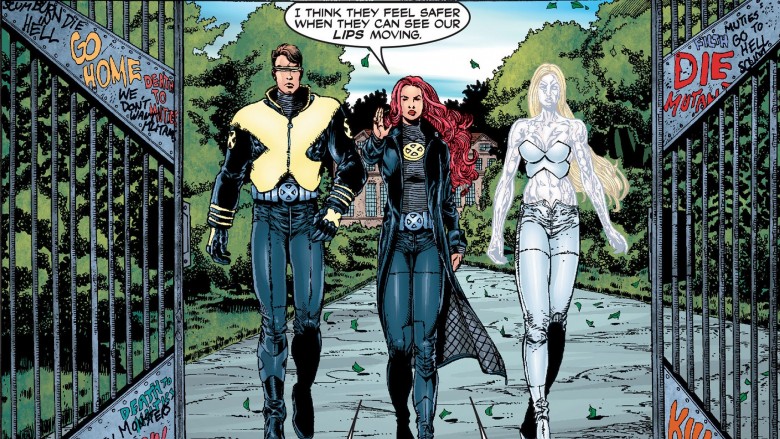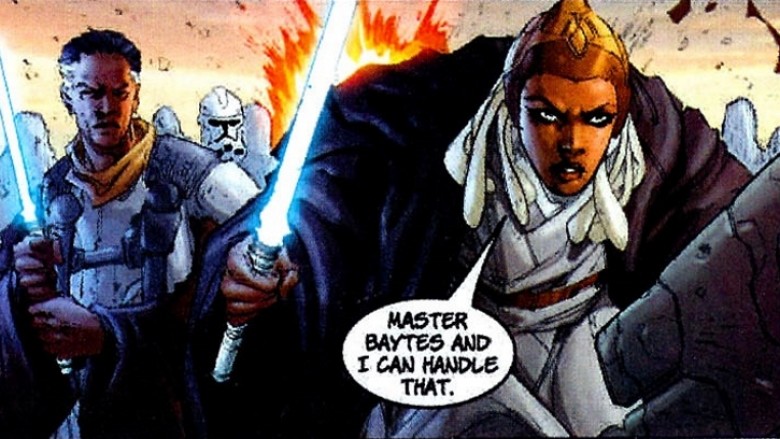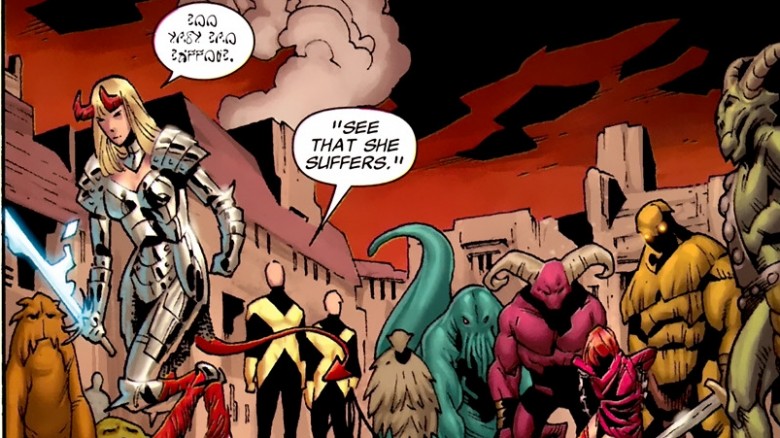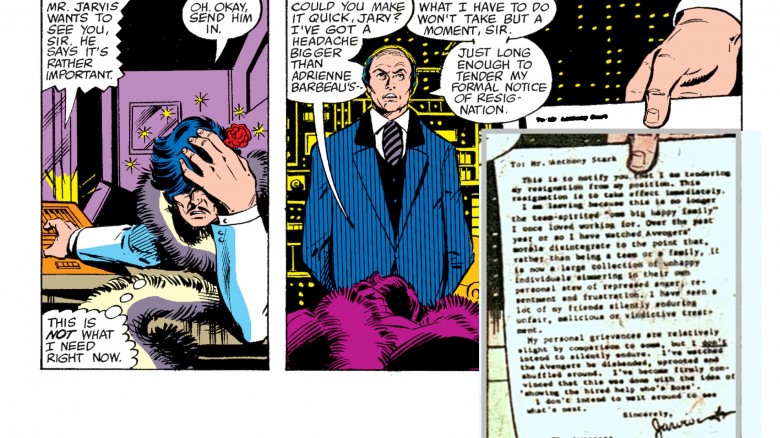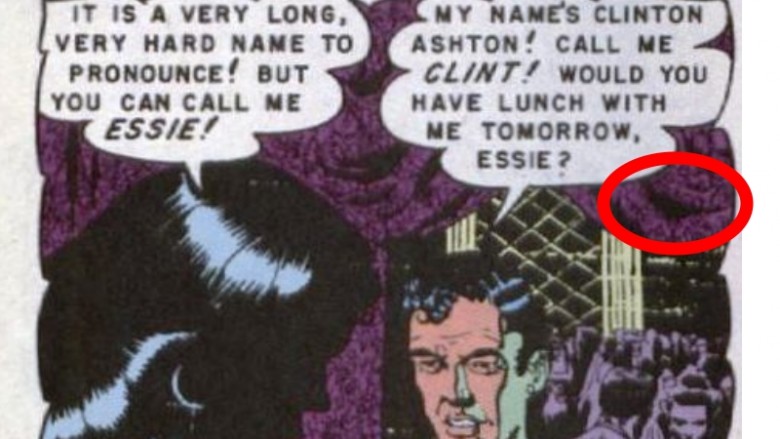Comic Book Creators Who Crossed The Line
Comic books take us to boundless, vividly imagined worlds, giving fans an escape route from the humdrum of daily life. In addition to their fantastical elements, comics can expand the mind, warp morality through the lens of irony, and often hold multiple layers of metaphor and allegory.
Of course, for many hard working creatives, the comic publishing world is just a job. Like any nine-to-fiver, sometimes an illustrator or author needs to blow off a little steam, dropping a covert sight gag or Easter egg between the panels. Unfortunately, some funny book artists and writers got a little carried away. These are the comic book creators who crossed the line.
Robert Kanigher
As a renowned DC comic writer and editor, Robert Kanigher was responsible for creating dozens of classic story arcs for the publisher, including expansive work across the publisher's war titles — in addition to narratives for Blue Beetle and Steel Sterling. He also helped create a number of fan favorite characters like heroine Black Canary and Batman's bent botanist Poison Ivy. Kanigher was best known for writing and editing Wonder Woman during an epic stint from 1946 to 1968, especially after creator William Moulton Marston passed away in 1947.
Throughout the years, Wonder Woman Diana Prince and her longtime series went through dozens of tweaks, retcons, and brief editorial changes. From time to time, Kanigher was shuffled off the book and replaced by a revolving door of editors and scribes, including Mike Sekowsky, who revamped Diana's origins in the 1960s. He gave her an Asian mentor, I-Ching, focusing more on her fighting skills and weapon skills and less on her mystical powers and giving the book a spy thriller feel. Along the way, several others, including Denny O'Neil and Dorothy Woolfolk (who championed Lois Lane) took up the editorial reigns on the character.
Apparently, Kanigher didn't cotton to some of the alterations. Upon his return, he literally killed some the changes to the story, having a sniper take out I-Ching. He also didn't much care for short term editor, Woolfolk, though whether for personal reasons, character alterations, or more nefarious, era-based gender biases is unclear. His errant gunman put a bullet through Wonder Woman's Dottie Cottonman, the editor of "Woman's Magazine" in #204—which requires minimal imagination-stretching to connect to DC's romance wing word-crafter.
Ernie Colon
Harvey Comics made its name by taking over Speed Comics, in addition to relicensing popular superhero comics like the Green Hornet and Dick Tracy and adapting properties like Casper the Friendly Ghost. Born from the company's eventual expansion into original characters, Harvey's, "poor little rich boy," Richie Rich, first arrived on the scene, moneybags and all, in 1953—along with a wave of quirky, big-headed children characters like Little Dot and Wendy the Good Little Witch. Created by Warren Kremer, Richie, who lived in anthology form beforehand, was given a series of his own in 1960. At that point, the adventures of the wealthy tyke took off, making him Harvey's "biggest star" and eventually landing him an animated series and a Macaulay Culkin feature film in 1994.
During his halcyon days, Richie starred in several comic series of his own. The millionaire young'un was also on the receiving end of a lewd gag in Dollars and Cents #28 from 1968. Now-fabled artist Ernie Colon, who got his start with Harvey Comics, decided to have some naughty fun with the readers. In the book, Richie expresses his frustration with vinyl, as it simply doesn't capture the hi-definition audio he desires. Insisting stereophonic audio is simply not authentic enough, instead of a turntable, he shows off his literal house band to his cousin (the also-stinking rich Reggie Van Dough Jr). The groovy songsters gigging at Rich's mansion, however, have the dubiously adult-oriented name of "Jizm" (yeah, we're not touching that one).
It seems Harvey's editors weren't up on all the slang of the era.
Unknown curse-sketcher
Everyone loves a good prank, right? Well, everyone except the unlucky recipients of them — although most of us are good-natured enough to play for the sake of fun. Comic book editors and publishers are probably less-likely to enjoy being a gag, though, particularly if makes them look foolish and costs their company money. Still, cornball writers and illustrators have been sneaking little Easter eggs and innuendoes into the pages of their work for decades.
One notorious prankster hit the pages of DC in 2010. Deadpool co-creator and famed '90s comic scribe Fabian Niceza and Buffy the Vampire Slayer penciler Cliff Richards crafted a one-shot for a series of standalone comics that spun off DC's Dark Knight. Before releasing the first issue, Bruce Wayne: The Road Home: Batman And Robin #1, DC sent out promo art — even featuring it prominently on their website — that included page samples and cover images, in addition to a hidden bonus for astute readers. Thanks to an unknown touch-up artist, the first page included a colossal, semi-obscured four-letter word — the very same one reputedly signifying the possession of unlawful carnal knowledge.
After the entertainment news gurus at Bleeding Cool discovered the accursed word, DC quickly pulled the advertisement. While the culprit and the end result of the SNAFU were never made public, DC's editorial department unquestionably had a very red face and a rough couple of days.
Al Milgrom
We all wind up with at least a couple of bosses that really rub against our grain. Sometimes, our workaday world is so rough on the nerves that we consider switching careers. Other times, we get lucky and our least favorite higher-ups find a new place of employment. For one Marvel artist, the departure of his editor couldn't have come soon enough.
While working on the first issue of the alternative timeline Spider-book, Universe X: Spidey #1, artist Al Milgrom left a "touching farewell" for his former editor, Bob Harras. Hidden in the bookcase behind a middle-aged and self-deluded Peter Parker are a number of curiously titled books. When flipped on their ends, the titles blend together into: "Bob Harras. Ha ha he's gone. Good riddance to bad rubbish. He was a nasty S.O.B."
Roughly 4,000 copies of Spidey — including a thousand variant covers — hit retailers early as part of Marvel's First Look program. The libelous little note was discovered soon thereafter, and the publisher recalled the remainder of the run, pulping the offending issues. Milgrom was fired for his shenanigans. However, rumor has it the longtime comic artist was back at work shortly thereafter. Apparently, someone else at the House of Ideas wasn't a Harras fan either.
Ethan Van Sciver
Comic book artists and authors, like anyone else, find themselves frustrated with their working environment. Bored with their assignments or overwhelmed by their workload, creatives do their best to adjust to things by rearranging their contracts, trying to switch editors, or shopping their services to other companies. Other artists choose entirely more amusing, if juvenile, forms of protest.
Comic book artist Ethan Van Sciver is somewhat notorious for hiding somewhat subtle messages in comic books, including his carefully arranged anagram on the cover of Justice League of America #5. Despite this, his status as a sought-after artist apparently allows him lax editorial supervision. Sciver truly made his mark in New X-Men #118, written by the modern legend Grant Morrison. Sciver was irritated with Marvel at the time, and as a result, decided to sneak the word "sex" into nearly every panel of the 2001 comic.
Hijinks or not, Van Sciver remains a noteworthy and highly sought artist in the medium. Perhaps he simply misunderstood or overstepped Marvel's pronouncement to "sexy up" the X-Men.
Randy Stradley
Seeing as the Star Wars universe launched with only one female character — and is now up to just a few more — it's unsurprising that the far-away galaxy is home to some self-gratification. In particular, one story line from the sidelined Expanded Universe, now called Star Wars Legends, introduced an amusing new Jedi Master. We know what you're thinking: it's not Kit Fisto. He's very much a part of the canon.
Despite The Phantom Menace's divisive reception, Star Wars fever gripping the nation in 2000. Dark Horse Comics, who held the comic rights to the saga at the time, was busy cranking out scores of fascinating and, at times, convoluted stories. Writer Randy Stradley, along with artist Davide Fabbri, put together a miniseries based on the Force-overseers, Jedi Council: Acts of War. Set a year before the events of the first prequel, a new, Force-immune threat tasks the Republic, shaking the usually steady hand of the Jedi. To combat the challenge, the Council brought in a few new faces, including Stradley's newly minted minor character, Master Soon Baytes.
According to a post Stradley himself made in a forum thread about the subject, he was annoyed that Lucas Licensing Editor, Sue Rostoni slapped a "Master" in front of every Jedi name as a reminder to him and other writers. "See, the thing was, Sue Rostoni would go through my scripts and if, for instance, I had a character refer to Yoda as just plain 'Yoda,' she would change it to 'Master Yoda,'" Radley wrote in the forum. "So, I introduced a completely unimportant tertiary Jedi character named Soon Baytes, hoping that she would be going through the script, come across the character, and change him to 'Master Baytes,' and I could say 'gotcha!' and then change the character's name to something more suitable."
Unfortunately, Rostoni, who claimed to be off the title at the time, and the other editors failed to catch the wordplay, and Master Bayts became a part of the council—at least until Disney disqualified much of the Expanded Universe in 2012. Stradley, acting as an editor on Star Wars: Obsession #4, returned his onanistic Jedi to action, having the mechanized menace General Grievous kill off his joke. Somehow, we doubt Disney will ever make Soon Bayts part of official lore.
Unknown demon linguist
Comic books are filled with fascinating takes on communication. Clever authors and equally imaginative artists often invent new species, new characters, and even wholly unique languages. Some of these linguistic concepts remain mysterious without any context or meaning beyond the scope in the story...but not always.
The third volume of Marvel's New Mutants arrived in 2009, returning the X-Men's second class to action. Penned by Zeb Wells and drawn by Leonard Kirk, the 17th issue, from 2010, dealt with original team member Illyana Rasputin, or Magik, who rules the alternative dimension Limbo. Along the way, one of the creatives put together a curious linguistic form that Magik uses to communicate with her hench-demons. The Limbo-speak would have likely gone down as just another clever bit of Marvel gibberish were it not for a few astute code-crackers that uncovered its letter-substitution cipher.
It turns out that Limbo-ites have filthy mouths. The devilish dialog sometimes translates into semi-nonsensical word balloons, such as Magik's battle cry of "Pork Chop." Other snippets are a little more risqué, including one conversation between the X-woman and her head honcho, which goes something like this: "Did you see that guy's [genitals]?" "Yeah, they were weird." Several other bubbles...well, we can't translate them here.
So far, no one has claimed credit for Limbo's unique language, which is entirely understandable.
Unknown letter-swapper
The life of superheroes isn't all bashing bad guys and flexing muscles. Over the years, Marvel and DC have run their fair share of moving tales that tugged on heartstrings with relevant, real-world issues. One of the most iconic and humane narratives of the 1970s was Tony Stark's battle with alcoholism, an issue the character still deals with to this day — but was mostly glossed over in the Marvel Cinematic Universe.
In Iron Man #127 — a particularly poignant issue written by David Michelinie, with art by Bob Layton — Tony's long-suffering butler Jarvis decries the billionaire playboy for letting his tipsy lady friend play with powerful weaponry. Stark verbally wallops his old chum for crapping on his parade, and as a result, Jarvis tenders his resignation the very next day. The powerful issue, one which presaged the legendary "Demon in a Bottle" story arc, saw Stark slowly come to terms with his biggest flaw. The only problem is, Jarvis' would-be moving missive wasn't the one intended to run in the issue. Instead, it was a genuine letter of resignation from former Marvel illustrator, Dave Cockrum.
Although slightly modified — with "Avengers" swapped for "Marvel" in the comic — some "clever" post-production staffer swapped out Jarvis' dispatch with Cockrum's recent note. Whether the fudged reprint was a move of solidarity or a nasty prank, it caused no end of embarrassment for the publisher. Author Michelinie even apologized for the mix-up in the letters column of Iron Man #130. In the end, the true culprit may have pranked their way out of a job.
Joe Orlando
Educational Comics — later Entertaining Comics, or EC for short — enjoyed a brief but highly influential run following its inception in 1944. After the congressional hearings of the early 1950s, the industry came under fire from all sides. EC found itself under heavy scrutiny for its racy horror, standards-bending science fiction, and gritty crime drama. The industry self-regulated in 1954, adapting the conservative Comics Code Authority, banning any gruesome or sexualized acts. EC was never able to find their audience afterwards and folded shortly thereafter.
Since the company's demise, though, the raw yet revolutionary narratives and artwork have lived on in reprints, film, and television — in particular, the classic Tales from the Crypt series. Former EC artist Joe Orlando, who eventually became a DC Comics bigwig, sketched up a number of scare fares for the publisher. One issue in particular, Tales from the Crypt #29 from 1952, featured an appropriately twisted tale about a scuzzy man and his would-be conquest—as well as some highly inappropriate hidden art, which managed to escape scrutiny for more-than three decades.
Printed in lush colors, the original issue hid the spicy scene, which depicted several sexual acts in progress on the club curtains behind the main characters. The pornographic sequence wasn't discovered until the '70s, when much of EC's back catalog was reissued in large format and printed in black and white. Blown up and lacking color, the naughty drapery was revealed in all its glory. Brought to EC founder William Gaines' attention, he called out Orlando on his racy artwork in his inimitable fashion. The DC editor responded in kind, flippantly dismissing the artwork and his antics, instead blaming it on Gaines' editors and their attempt to "corrupt the morals of America's youth" — before offering to buy the original panels back.

